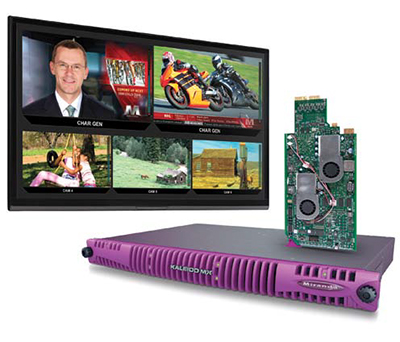Multiviewers Moving Toward 4K, IP Adoption
OTTAWA—For broadcasters adopting multiviewer technology in the production facility, being able to display multiple video windows on a single display is no longer enough. Today’s users have all kinds of cutting- edge applications that they want to use multiviewers for, which multiviewer manufacturers are working hard to provide.
“Customers are looking for increased flexibility in how multiviewers can be applied in their workplaces,” said David Wood, owner/chief design engineer with Ensemble Designs in Grass Valley, Calif. “For instance, with broadcasters having fewer staff than before, customers want multiviewers that can actively detect and report faults in program content without human intervention.”
Imagine communications has integrated advanced multiviewer functionality directly within its Platinum family of routers, reducing space, power requirements and complexity. TOP OF THE LIST
Ask multiviewer manufacturers what trend customers are talking about most, and the answer is 4K.

“Broadcasters are interested in how 4K monitors can be integrated with multiviewers today in their current control rooms, to improve their 720p/1080i monitoring capabilities,” said Daniel Maloney, technical products manager for Matrox in Montreal. “In fact, a 4K monitor using a quad split can display four 1080p video windows today. Even if you reduce resolution by adding more windows, the resulting resolution per window is four times better than if seen on a 1080p display.”
Adding to broadcaster/producer interest is the drop in 4K monitor prices. “In particular, 4K 30hz monitors are becoming relatively affordable,” said Thomas Tang, president of Apantac in Portland, Ore. “With a large 4K 30hz display, you can replace a 2 x 2 video wall at a very affordable price.”
This matters, because budgets remain tight at U.S. TV stations and post houses. “In the current economy, people want to make minimal investments for their video monitoring facilities,” said For-A America vice president Jay Shinn in Fort Lee, N.J. “Thankfully, the ability of today’s multiviewers to support 4K by combining four 1080p outputs, and the falling price of 4K displays, is fitting nicely within their needs.”
Martin Jolicoeur, product manager for Grass Valley in Montreal, concurs. “Using today’s multiviewers combined with 4K displays, broadcasters can substantially improve their monitoring quality with the higher resolution of the display without having to upgrade their entire plant to 4K.”
The professional video industry's #1 source for news, trends and product and tech information. Sign up below.
ADDING IP TO THE MIX
Using IP for signal distribution in the facility plant is becoming increasingly important to broadcasters; whether as inputs from the Web for inclusion in on-air broadcasts, or as streaming end-products delivered to viewers on the Web and by wireless.
As a result, customers want multiviewers that can seamlessly integrate and deliver both base-band and IP video signals onto the same large display. “Video producers want to see all of their main sources on the same screen, regardless of where those sources come from,” said Jamie Horner, director of system solutions for Evertz Micro in Burlington, Ontario. “This is why multiviewers are evolving to offer this capability.”
At the same time, broadcasters want to see how their products appear to end users; especially those watching streaming content over the Web.
“Under the ‘TV Everywhere’ model, broadcasters are providing content to HDTVs, computers, tablets and smartphones,” said Robert Millis, senior product manager of measurement and monitoring products at Imagine Communications in Dallas. “Multiviewers need to be able to show these varying end products in a central location—alongside baseband and outgoing IP feeds—so that broadcasters can accurately monitor and tweak their signals in real time.”
SAVING SPACE
Even with miniaturization, space is tight in today’s master control and post-production rooms. In response, manufacturers are integrating multiviewers into routers.

Grass Valley Kaleido MX “A modular integrated product uses less space and less power than two separate units and reduces complexity,” said Steve Copeland, director of product management for Imagine Communications. “We’ve designed ours to go one step further by supporting expansion in our routers without requiring extra rack space.”
Another space saver: Grass Valley has developed the M3 3 Gbps cable to reduce wiring between the company’s Nvision routers and Kaleido-MX multiviewers. “This cable effectively reduces the cable count between these units by a count of 16,” Jolicoeur said.
Time matters as well; particularly when it comes to switching multiviewer configurations from program to program. “The latest ‘smart’ multiviewers make it easy to create individual configurations for each program, and to store them for quick recall later,” said Ensemble Designs’ David Wood. “This is a tremendous time-saver.”
All these trends point to one inescapable conclusion: Multiviewers are becoming multifunctional, integrated and vital elements of today’s broadcast/production environments. As such, multiviewer technology is evolving quickly to encompass all of these demands, and to be sufficiently scalable to keep up with whatever its users think of next. The industry has come a long way from multiviewers existing solely to replace dedicated single-source monitors; a long way indeed.
James Careless is an award-winning journalist who has written for TV Technology since the 1990s. He has covered HDTV from the days of the six competing HDTV formats that led to the 1993 Grand Alliance, and onwards through ATSC 3.0 and OTT. He also writes for Radio World, along with other publications in aerospace, defense, public safety, streaming media, plus the amusement park industry for something different.

